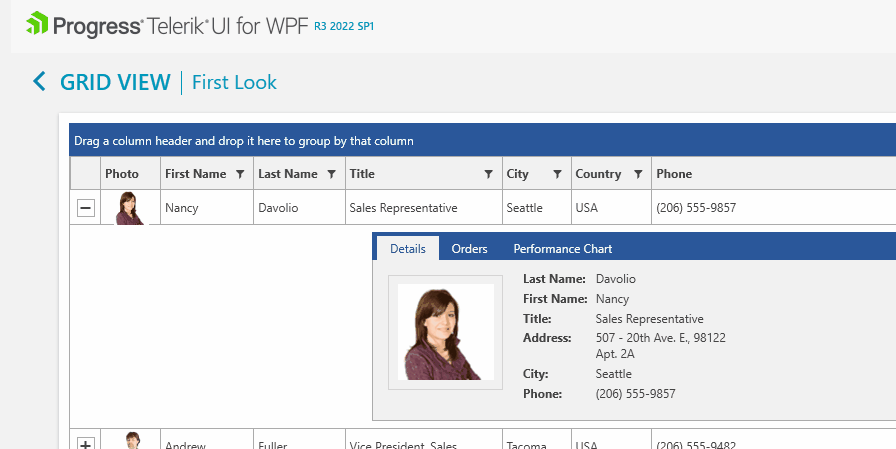i hope add char controls
like :
https://developers.google.com/chart/interactive/docs/gallery/timeline
https://github.com/dreamRs/timelineschart
The System.Drawing.Common package is installed in the project that builds Telerik.Windows.Controls.Navigation.dll for .NET Core 3.1 Core, .NET 5 and .NET 6. The current package version is 4.7.0.
Update the package to the latest available version.
Hi,
we are using our own IPagedCollectionView implementation in combination with the RadDataPager control as shown in the attached example project. Basically, we bind an instance of the PagedCollectionView that is provided by our ViewModel to the Source property of the RadDataPager.
Recently we started to take implementing the Dispose pattern a bot more seriously and also added the IDisposable interface to our custom PagedCollectionView (in order to Dispose some internally used CancellationTokenSource). Today we realized that the RadDataPager now calls Dispose() on the PagedCollectionView instance although not being its owner. This happens as soon as the DataPager itself is Disposed e.g. by switching modules (and thus loading a new DataTemplate) in our multi-module application. Coming back to the module will then cause the disposed Collection to be used again, potentially causing ObjectDisposedExceptions etc.
What I would expect: The RadDataPager control should not call Dispose() on its Source collection if it is Data-Bound to a ViewModel since that might leave the ViewModel in an invalid state that can cause Exceptions later on.
The problem exists with .net 6 and .net Framework 4.8 as well as with versions 2022.3.1109 (Xaml, see Example project) and 2022.2.621 (NoXaml)
There seems to be a bug concerning tabs headers of TabControl when used with Office2016 theme.
The color of the header changes from white (active tab) to light blue when a control on this tab is hovered. White background is shown only when mouse hovers only over TabControl Tab panel directly. See gif attached.
Hi Team,
having a "Signature" component in your WPF package like you have in your Blazor package will be very interesting.
Regards
Al
The following exception is thrown when changing the theme of an element with the StyleManager runtime:
Cyclic reference found while evaluating the ThemeStyle property on element 'Telerik.Windows.Controls.Gauge.Needle'.
This only occurs in some themes, such as Fluent, Crystal, and Office2016.
Can be reproduced in the WPF demo (Windows8 theme): the error description tooltip appears on the left of the control and with the red arrow on the left (see attachment). The tooltip should appear on the same side of the red adorned element (the red triangle, top right corner) and the tooltip arrow should point the control.
Selecting a pinned row or column results in wrongly selected indexes.
Steps to reproduce:
Case #1:
1. Pin a row
2. Select the pinned row
result: a wrong row is selected
Case #2:
1. Pin one column
2. Select a cell from the pinned column
Result: The visual selection is for the first unpinned cell. The selected indexes are wrong too. The Column index is always 0
Latest version of wpf ui on NET6 I receive this error with Office2019 theme, also tested with Office2016 theme and there is no error.
System.Windows.Markup.XamlParseException: "Die Angabe eines Werts für "System.Windows.Markup.StaticResourceHolder" führte zu einer Ausnahme."
Exception: Die Ressource mit dem Namen "RepeatButtonStyle" kann nicht gefunden werden. Bei Ressourcennamen wird die Groß- und Kleinschreibung berücksichtigt.
Diese Ausnahme wurde ursprünglich von dieser Aufrufliste ausgelöst:
System.Windows.StaticResourceExtension.ProvideValueInternal(System.IServiceProvider, bool)
System.Windows.StaticResourceExtension.ProvideValue(System.IServiceProvider)
MS.Internal.Xaml.Runtime.ClrObjectRuntime.CallProvideValue(System.Windows.Markup.MarkupExtension, System.IServiceProvider)
I have a RadComboBox which is causing the error. When I remove this element, error is gone. Error only happens when I click on the drowdown. The error happens before dropdown open.
I use this files<ResourceDictionary Source="/Telerik.Windows.Themes.Office2019;component/Themes/Telerik.Windows.Controls.xaml" />
<ResourceDictionary Source="/Telerik.Windows.Themes.Office2019;component/Themes/System.Windows.xaml" />
<ResourceDictionary Source="/Telerik.Windows.Themes.Office2019;component/Themes/Telerik.Windows.Controls.Input.xaml" />
<ResourceDictionary Source="/Telerik.Windows.Themes.Office2019;component/Themes/Telerik.Windows.Controls.Navigation.xaml" />
<ResourceDictionary Source="/Telerik.Windows.Themes.Office2019;component/Themes/Telerik.Windows.Controls.DataVisualization.xaml" />
<ResourceDictionary Source="/Telerik.Windows.Themes.Office2019;component/Themes/Telerik.Windows.Controls.GridView.xaml" />
<ResourceDictionary Source="/Telerik.Windows.Themes.Office2019;component/Themes/Telerik.Windows.Controls.RibbonView.xaml" />

